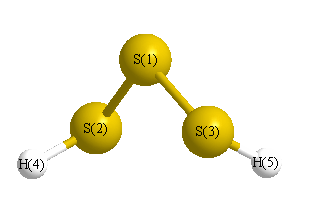Jump to
S1C2
Energy calculated at CCSD(T)=FULL/cc-pVDZ
| | hartrees |
|---|
| Energy at 0K | -1194.230346 |
| Energy at 298.15K | -1194.232641 |
| HF Energy | -1193.755692 |
| Nuclear repulsion energy | 192.386058 |
The energy at 298.15K was derived from the energy at 0K
and an integrated heat capacity that used the calculated vibrational frequencies.
Vibrational Frequencies calculated at CCSD(T)=FULL/cc-pVDZ
| Mode Number |
Symmetry |
Frequency
(cm-1) |
Scaled Frequency
(cm-1) |
IR Intensities
(km mol-1) |
Raman Act
(Å4/u) |
Dep P |
Dep U |
|---|
| 1 |
A |
2688 |
2589 |
|
|
|
|
| 2 |
A |
874 |
842 |
|
|
|
|
| 3 |
A |
476 |
458 |
|
|
|
|
| 4 |
A |
302 |
291 |
|
|
|
|
| 5 |
A |
200 |
193 |
|
|
|
|
| 6 |
B |
2687 |
2588 |
|
|
|
|
| 7 |
B |
865 |
833 |
|
|
|
|
| 8 |
B |
469 |
452 |
|
|
|
|
| 9 |
B |
329 |
317 |
|
|
|
|
Unscaled Zero Point Vibrational Energy (zpe) 4444.7 cm
-1
Scaled (by 0.9632) Zero Point Vibrational Energy (zpe) 4281.1 cm
-1
See section
III.C.1 List or set vibrational scaling factors
to change the scale factors used here.
See section
III.C.2
Calculate a vibrational scaling factor for a given set of molecules
to determine the least squares best scaling factor.
Geometric Data calculated at CCSD(T)=FULL/cc-pVDZ
Point Group is C2
Cartesians (Å)
| Atom |
x (Å) |
y (Å) |
z (Å) |
|---|
| S1 |
0.000 |
0.000 |
0.869 |
| S2 |
0.000 |
1.684 |
-0.398 |
| S3 |
0.000 |
-1.684 |
-0.398 |
| H4 |
-1.341 |
1.758 |
-0.587 |
| H5 |
1.341 |
-1.758 |
-0.587 |
Atom - Atom Distances (Å)
| |
S1 |
S2 |
S3 |
H4 |
H5 |
| S1 | | 2.1071 | 2.1071 | 2.6473 | 2.6473 |
S2 | 2.1071 | | 3.3679 | 1.3562 | 3.6986 | S3 | 2.1071 | 3.3679 | | 3.6986 | 1.3562 | H4 | 2.6473 | 1.3562 | 3.6986 | | 4.4217 | H5 | 2.6473 | 3.6986 | 1.3562 | 4.4217 | |
 More geometry information
More geometry information
Calculated Bond Angles
| atom1 |
atom2 |
atom3 |
angle |
|
atom1 |
atom2 |
atom3 |
angle |
| S1 |
S2 |
H4 |
97.329 |
|
S1 |
S3 |
H5 |
97.329 |
| S2 |
S1 |
S3 |
106.104 |
|
Electronic energy levels
Charges, Dipole, Quadrupole and Polarizability
Jump to
S1C1
Energy calculated at CCSD(T)=FULL/cc-pVDZ
| | hartrees |
|---|
| Energy at 0K | -1194.230023 |
| Energy at 298.15K | -1194.232325 |
| HF Energy | -1193.755219 |
| Nuclear repulsion energy | 192.399758 |
The energy at 298.15K was derived from the energy at 0K
and an integrated heat capacity that used the calculated vibrational frequencies.
Vibrational Frequencies calculated at CCSD(T)=FULL/cc-pVDZ
| Mode Number |
Symmetry |
Frequency
(cm-1) |
Scaled Frequency
(cm-1) |
IR Intensities
(km mol-1) |
Raman Act
(Å4/u) |
Dep P |
Dep U |
|---|
| 1 |
A' |
2680 |
2582 |
|
|
|
|
| 2 |
A' |
879 |
847 |
|
|
|
|
| 3 |
A' |
476 |
458 |
|
|
|
|
| 4 |
A' |
328 |
316 |
|
|
|
|
| 5 |
A' |
201 |
193 |
|
|
|
|
| 6 |
A" |
2682 |
2584 |
|
|
|
|
| 7 |
A" |
867 |
835 |
|
|
|
|
| 8 |
A" |
470 |
452 |
|
|
|
|
| 9 |
A" |
304 |
293 |
|
|
|
|
Unscaled Zero Point Vibrational Energy (zpe) 4443.5 cm
-1
Scaled (by 0.9632) Zero Point Vibrational Energy (zpe) 4279.9 cm
-1
See section
III.C.1 List or set vibrational scaling factors
to change the scale factors used here.
See section
III.C.2
Calculate a vibrational scaling factor for a given set of molecules
to determine the least squares best scaling factor.
Geometric Data calculated at CCSD(T)=FULL/cc-pVDZ
Point Group is Cs
Cartesians (Å)
| Atom |
x (Å) |
y (Å) |
z (Å) |
|---|
| S1 |
-0.054 |
0.866 |
0.000 |
| S2 |
-0.054 |
-0.400 |
1.683 |
| S3 |
-0.054 |
-0.400 |
-1.683 |
| H4 |
1.292 |
-0.524 |
1.804 |
| H5 |
1.292 |
-0.524 |
-1.804 |
Atom - Atom Distances (Å)
| |
S1 |
S2 |
S3 |
H4 |
H5 |
| S1 | | 2.1067 | 2.1067 | 2.6457 | 2.6457 |
S2 | 2.1067 | | 3.3668 | 1.3568 | 3.7404 | S3 | 2.1067 | 3.3668 | | 3.7404 | 1.3568 | H4 | 2.6457 | 1.3568 | 3.7404 | | 3.6087 | H5 | 2.6457 | 3.7404 | 1.3568 | 3.6087 | |
 More geometry information
More geometry information
Calculated Bond Angles
| atom1 |
atom2 |
atom3 |
angle |
|
atom1 |
atom2 |
atom3 |
angle |
| S1 |
S2 |
H4 |
97.242 |
|
S1 |
S3 |
H5 |
97.242 |
| S2 |
S1 |
S3 |
106.080 |
|
Electronic energy levels
Charges, Dipole, Quadrupole and Polarizability
